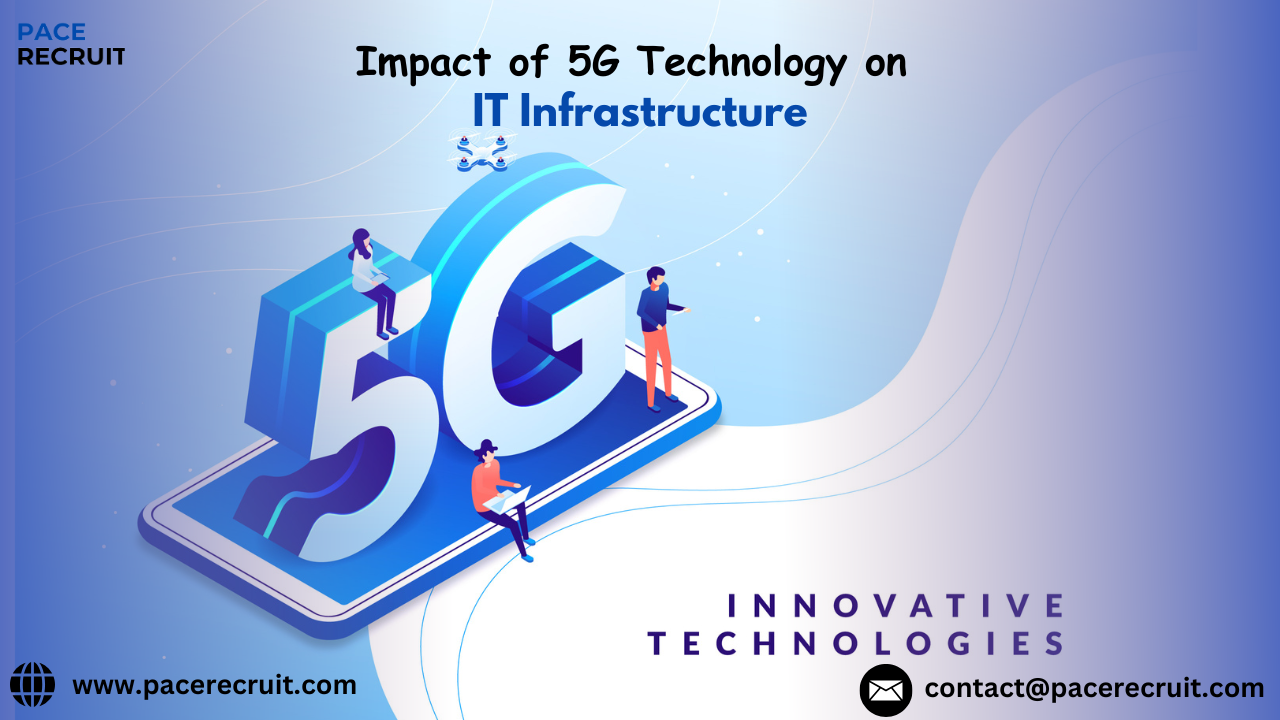The arrival of 5G is indeed revolutionizing the IT landscape. With the increasing dependence of businesses and industries on fast, latency-sensitive networks, transformation of IT infrastructure would automatically be required. Several ripples of change in terms of network architecture, cloud computing, and cybersecurity too may be expected due to 5G. In the present blog, we have elaborated the multifarious implications that 5G technology has been casting upon the IT ecosystem. Here’s what this technology says to enterprises that need to get prepared for tomorrow.
Table of Contents
Understanding 5G and Its Core Capabilities
5G technology is the fifth-generation wireless network designed to deliver ultra-fast speeds, low latency, and massive connectivity. Unlike its predecessor, 4G LTE, which primarily focused on mobile broadband, 5G networks enable advanced applications such as IoT (Internet of Things), autonomous vehicles, and AI-driven solutions. Some of the key features include higher data speeds that can go up to 10 Gbps, which is much faster than 4G. Ultra-low latency brings response times down to as low as 1 millisecond, which would be important for real-time applications. There is a very large number of devices per square kilometer in greater network capacity. Improved reliability ensures connection stability and better performance in networks.
How Changing 5G Technology on IT Infrastructure
Network Topology Change
The move towards 5G networks calls for a radical upgrade of the established network architecture. Traditional centralized data centers cannot take the strain to process ultrafast data. Decentralized data centers and edges are, thus, becoming integral parts of companies’ performance upgrades. Edge computing minimizes the latency of receiving data as more data is received closer to their source rather than being relayed from remote clouds. SDN provides dynamic and efficient management of networks through virtualization. NFV enables organization to put various network services onto standard hardware while diminishing reliance on expensive proprietary equipment.
Enhanced Capabilities in Cloud Computing
Cloud service providers use 5G technology to provide cloud services with fast and stable connectivity. Such an increased bandwidth and direct connectivity between devices of any kind allows businesses easily integrate cloud applications, function applications in real-time analytics using AI and ML models that require high-speed data transmission, and allow remote workforce solutions with high performing cloud-based collaboration tools.
Impact of 5G on Cybersecurity
Expansion of 5G networks introduces a host of cybersecurity issues. An extremely huge connected devices increase and data traffic make it more susceptible to cyber threats. Security concerns encompass an increased attack surface; there will be billions of IoT devices connected to 5G networks, giving cybercriminals a lot of entry points to exploit. Risks associated with network slicing arise as each slice requires security protocols that increase complexity. More significant and higher quantities require more complex encryption and security measures with regard to data privacy. The companies should apply zero-trust security models, end-to-end encryption, and AI-driven threat detection systems.
5G and the Internet of Things (IoT)
5G technology will certainly make an impact on the entire IoT ecosystem. With low latency and high device density, 5G enables smart cities, industrial automation, and intelligent healthcare solutions. Real-time traffic monitoring, connected infrastructure, and automated public services contribute to the benefits of smart cities. Furthermore, industrial IoT (IIoT) allows for predictive maintenance and robotic automation for better manufacturing efficiency. Healthcare will be developed with remote surgeries, telemedicine, and wearable health monitoring devices.
5G Impact on Data Center and IT Operations
Data centers need to adapt to the requirements of 5G-based applications. Moreover, growing data streams necessitate scalable storage, like faster SSDs, or distributed storage systems, with HPC workloads’ associated heat in the form of cooling systems and AI-based automation for data center optimizing using ML and predictive analytics.
The Future of 5G and AI Integration
The synergy between 5G and artificial intelligence is set to redefine multiple industries. AI-powered automation combined with real-time 5G connectivity will drive innovation in autonomous vehicles, ensuring instant vehicle-to-vehicle (V2V) communication for enhanced safety, smart retail, where AI-powered recommendation engines deliver personalized shopping experiences, and financial services, enabling real-time fraud detection and algorithmic trading with ultra-fast connectivity.
Conclusion
Upgrades to 5G networks will indicate transitional changes in terms of the complete design and orchestration of IT infrastructures. With such a perspective, the network has evolved, enhancing the work of cloud computing, affording better opportunities for cybersecurity, and integrating the Internet of Things. At this juncture, organizations need to leverage next-gen IT strategies in addressing the new challenges posed throughout the pathway of 5G. To attain congruence with this age of 5G-powered digital transformation, business entities also need to win over their investments in edge computing, AI security, and cloud solutions.
for more details about our collaboration contact us at www.pacerecruit.com/contact-us/
FAQs about 5G Technology on IT Infrastructure
1. What are the efficiency improvements to IT infrastructure owing to 5G?
Higher speeds for data transfer, very low latency, and improved network capacity for cloud computing, AI applications, and IoT deployment are ways by which 5G improves the IT infrastructure.
2. How does 5G support cloud computing?
5G expedites and ensures faster, more reliable access to applications on clouds, reducing lag, hence improving performance in organizations using remote work and digital collaboration.
3. Which industries can benefit the most from 5G technology?
The industries where there is considerable advancement are in healthcare, manufacturing, retail, transportation, and finance, considering real-time data processing and AI-driven automation powered by 5G.
4. How should businesses prepare for 5G adoption?
Edge computing, AI-driven cybersecurity, scalable cloud solutions, and IoT integration are necessary to maximize the benefits of 5G technology.


Thanks for this insightful blog! The explanation of how 5G technology is impacting IT infrastructure was really eye-opening. I appreciate the detailed analysis and the clear connection to real-world applications